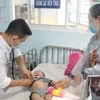 A household is locked down as it is the place of residence of a COVID-19 patient in Thanh Hoa province. (Photo: VNA)
A household is locked down as it is the place of residence of a COVID-19 patient in Thanh Hoa province. (Photo: VNA) The Ministry of Health on February 12 issued new guidelines on health monitoring for COVID-19 patients who are allowed to self-monitor at home. Vietnam registered 29,413 COVID-19 patients on February 14, the highest since the start of the pandemic.
Under the guidelines, COVID-19 patients are allowed to self-monitor at home but have to watch out for symptoms of fatigue, cough, coughing up phlegm, chills, conjunctivitis, loss of taste or smell, diarrhoea, coughing up blood, shortness of breath, persistent chest pain, drowsiness, sore throat, headache, dizziness, loss of appetite, nausea and vomiting and muscle aches.
The ministry said that while detecting any of the following signs, COVID-19 patients must immediately notify the commune and ward health station, mobile medical station, or emergency transportation centre for emergency treatment:
- The breathing rate is higher than 20 times per minute for adults and higher than 40 times per minute for children from 1 to under 5 years old; or higher than 30 times per minute for children from 5 to under 12 years old.
- The SpO2 is less than 96 percent (in case of detecting abnormal SpO2 index, it needs to be measured again after 30 seconds to one minute.
- The heart beats at higher than 120 beats per minute or lower than 50 beats per minute.
- The systolic blood pressure is lower than 90 mm Hg and the diastolic blood pressure is lower than 60 mm Hg.
- The patients feel frequent chest pain, tightness in the chest and pain when taking a deep breath.
- For adults, the patients fall into confusion, narcolepsy, lethargy and tiredness; for children, it is difficult to wake up.
- Purple lips, purple fingernails, toenails, blue skin, pale lips, cold fingertips and toes.
- Inability to drink, poor appetite, vomiting (in children). Children have multisystem inflammatory syndrome: high fever, red eyes, red lips, strawberry tongue and swollen fingers and toes, or having more acute diseases of dengue fever as well as hand, foot and mouth disease.
Dealing with a fever
For adults with a fever higher than 38.5 degrees Celsius or headache with severe body pain, patients need to take one antipyretic medicine such as Paracetamol of 0.5 g each time. They should take the medicine every four and six hours and no more than four tablets a day. The patient could take Ore-sol if he or she eats poorly or drinks instead of water.
For children with a fever higher than 38.5 degrees, parents or caregivers should give antipyretic medicine such as Paracetamol at a dose of 10-15 mg/kg each time. It can be repeated every four and six hours for no more than four tablets a day.
If after taking the fever-reducing medicine twice the fever is not reduced, the patient is required to immediately notify the COVID-19 Self-monitor Patient Management Facility for further treatment.
If the patient has a cough, he or she should use cough suppressants when the cough is very dry.
The ministry notes that the patients should rest and do light physical activity (suitable for their health status); focus on their breathing for at least 15 minutes a day; drink water regularly; not wait until thirsty to drink water; not skip meals; enhance nutrition including eating enough, eating fruit, and drinking fruit juice; think positively and maintain a comfortable mentality./.
VNA
























